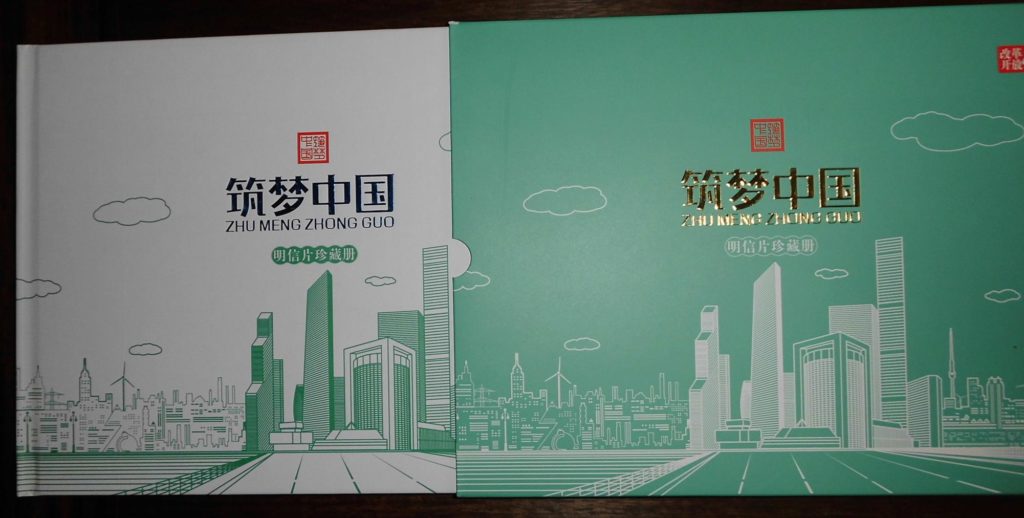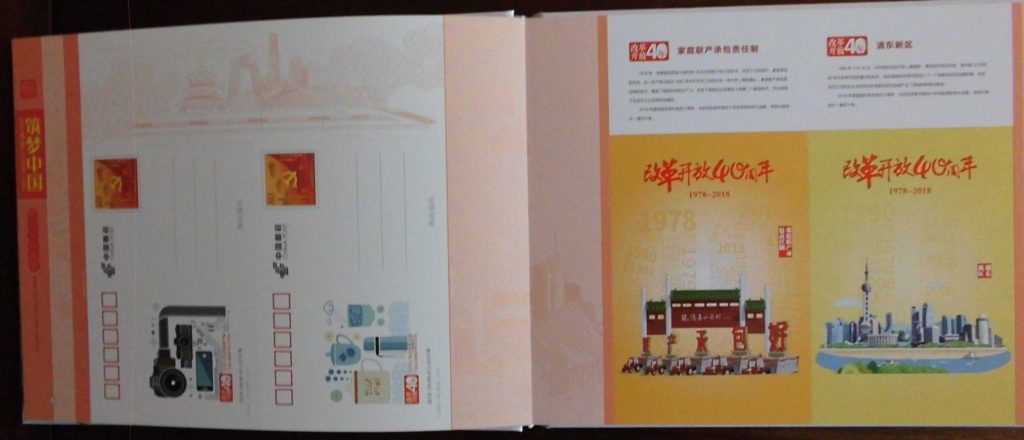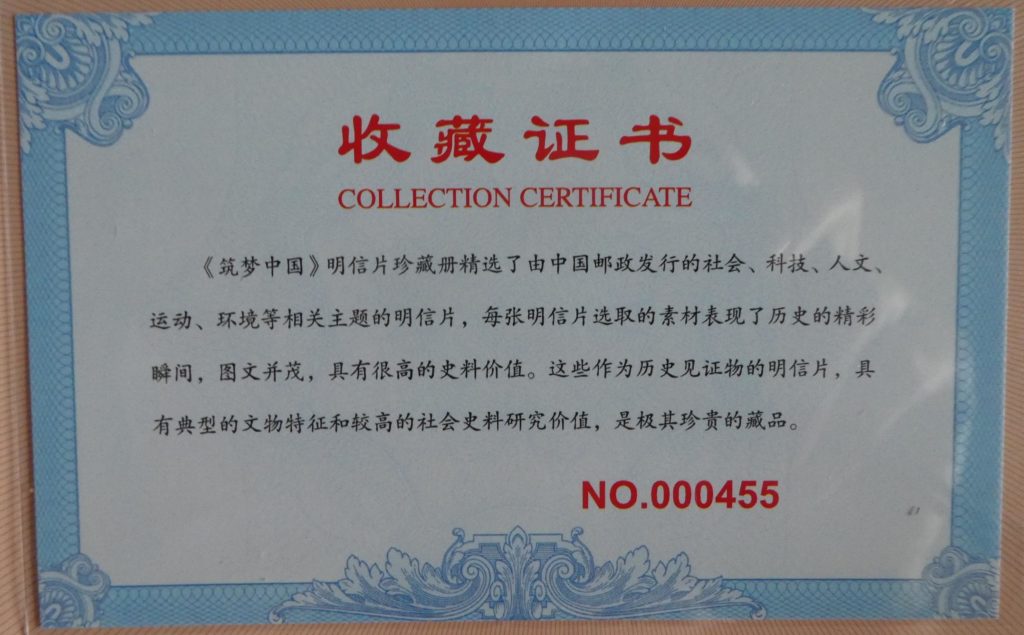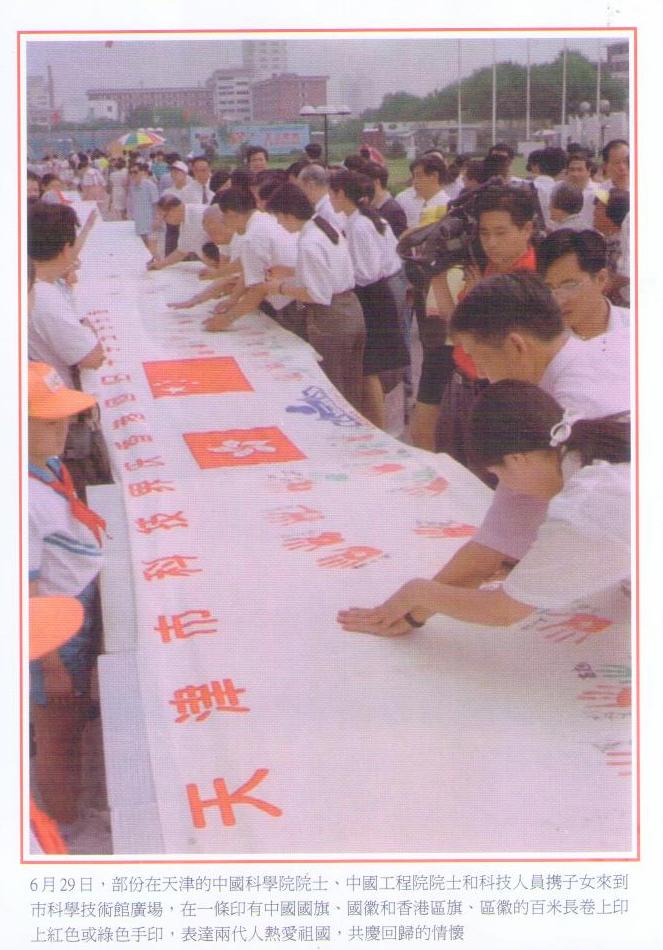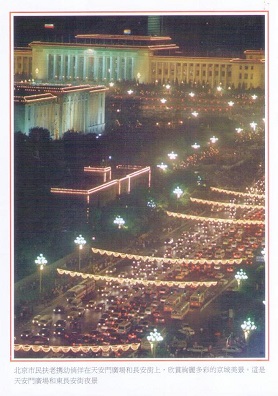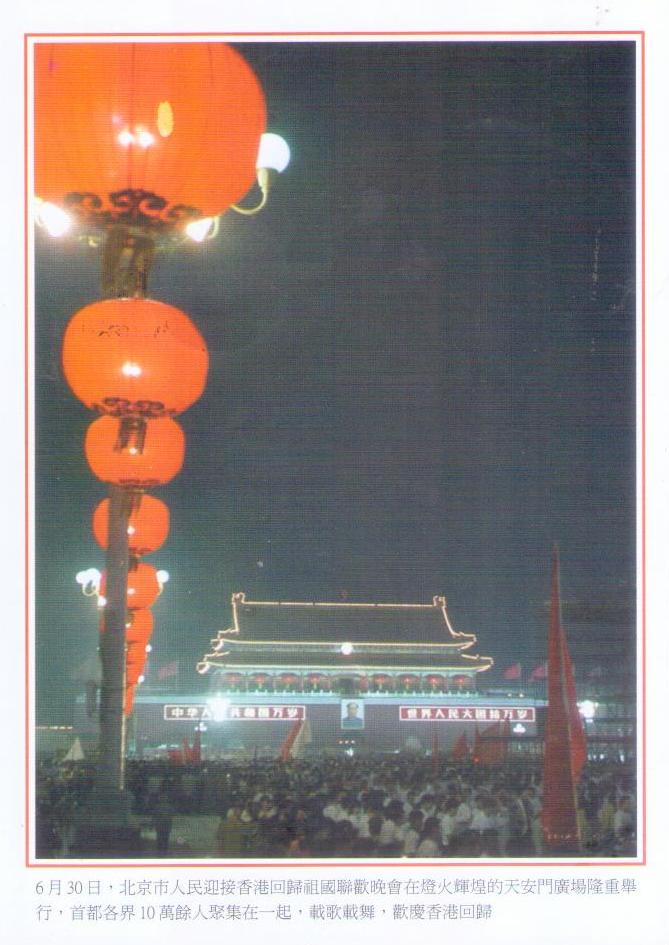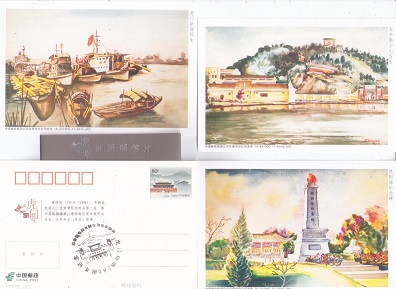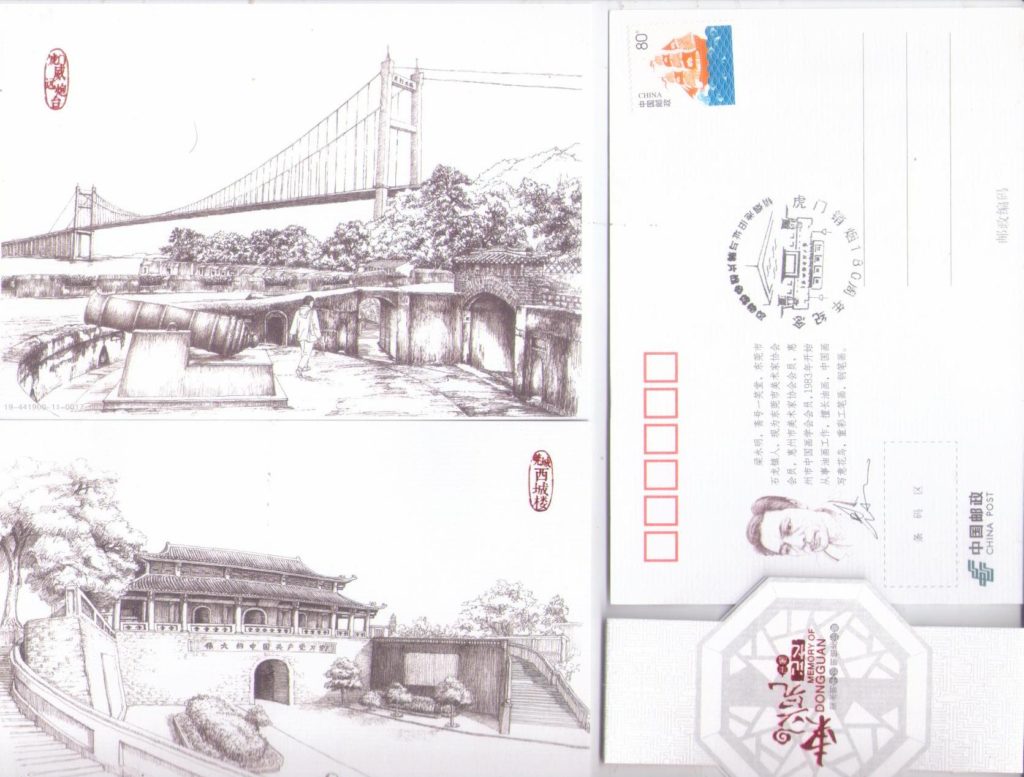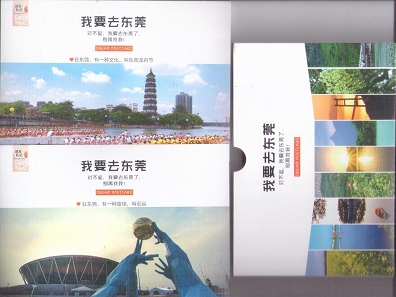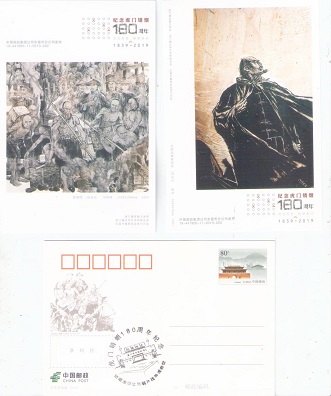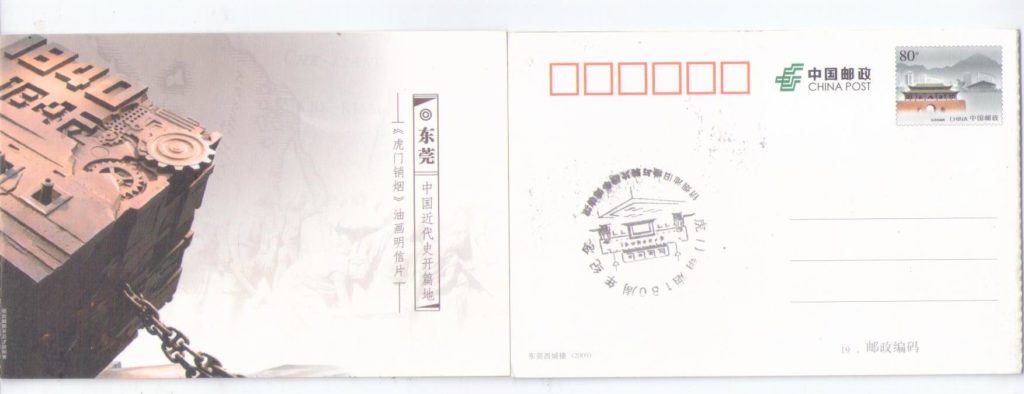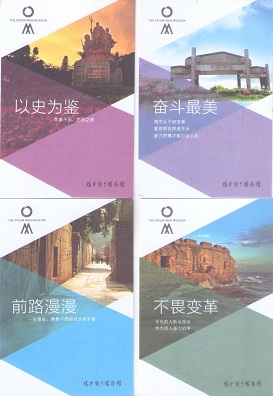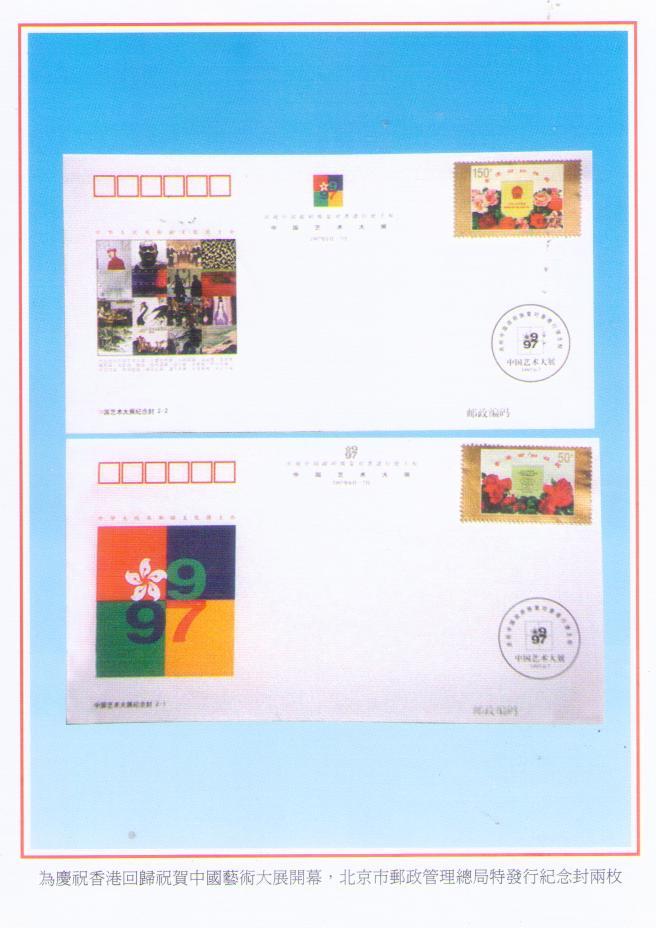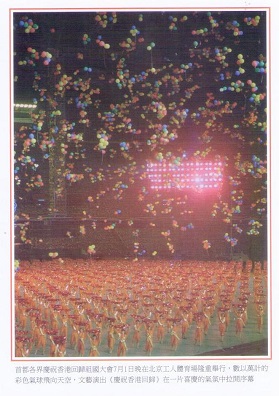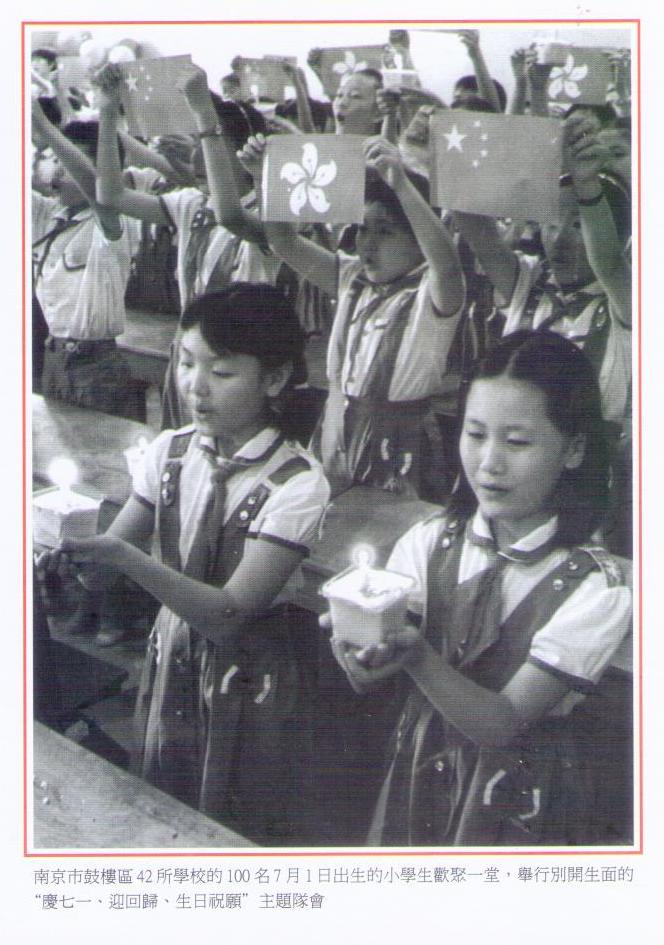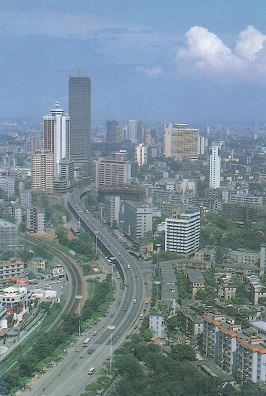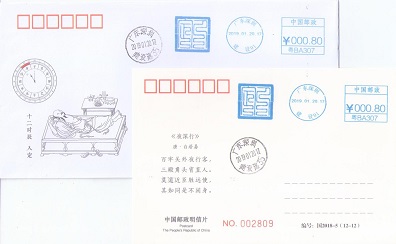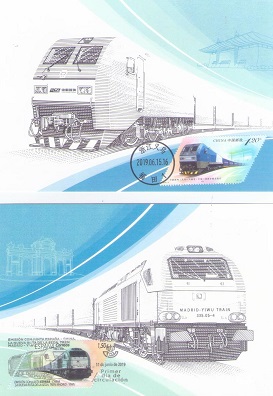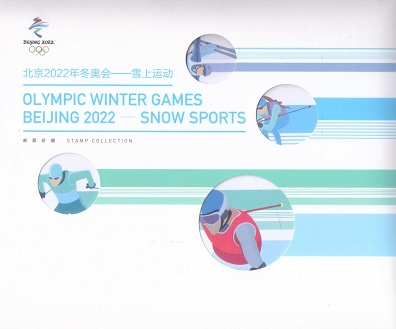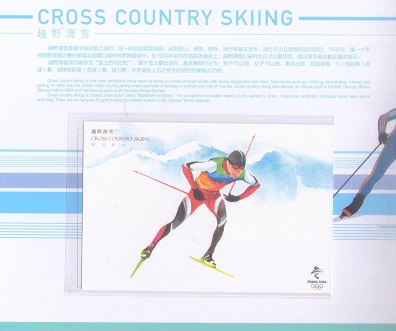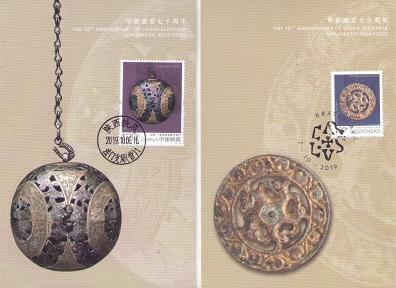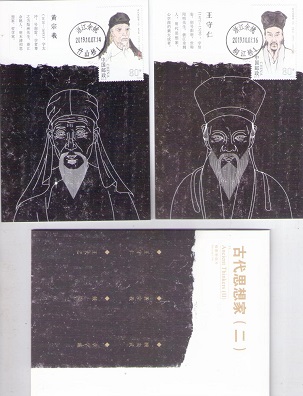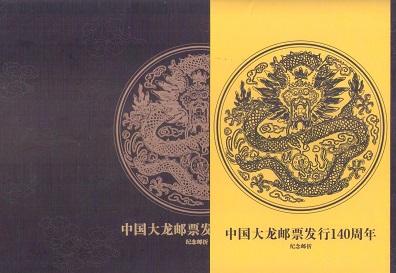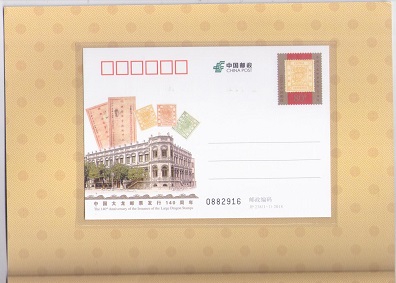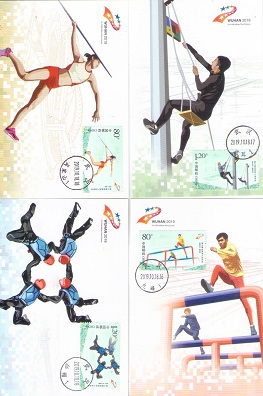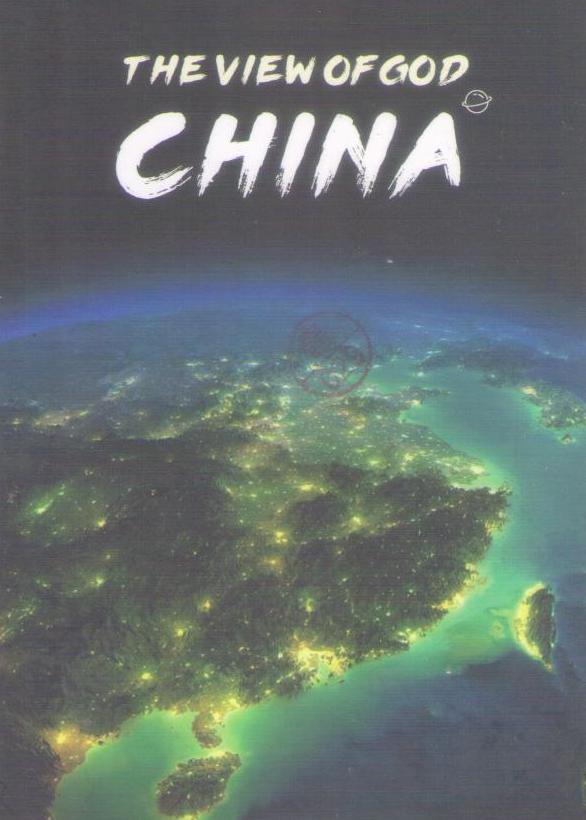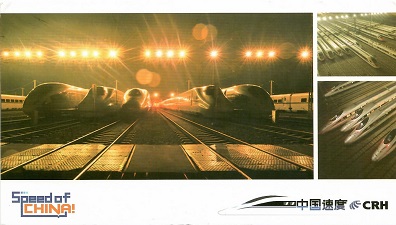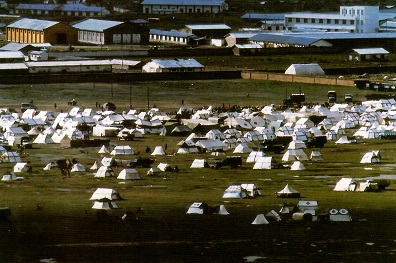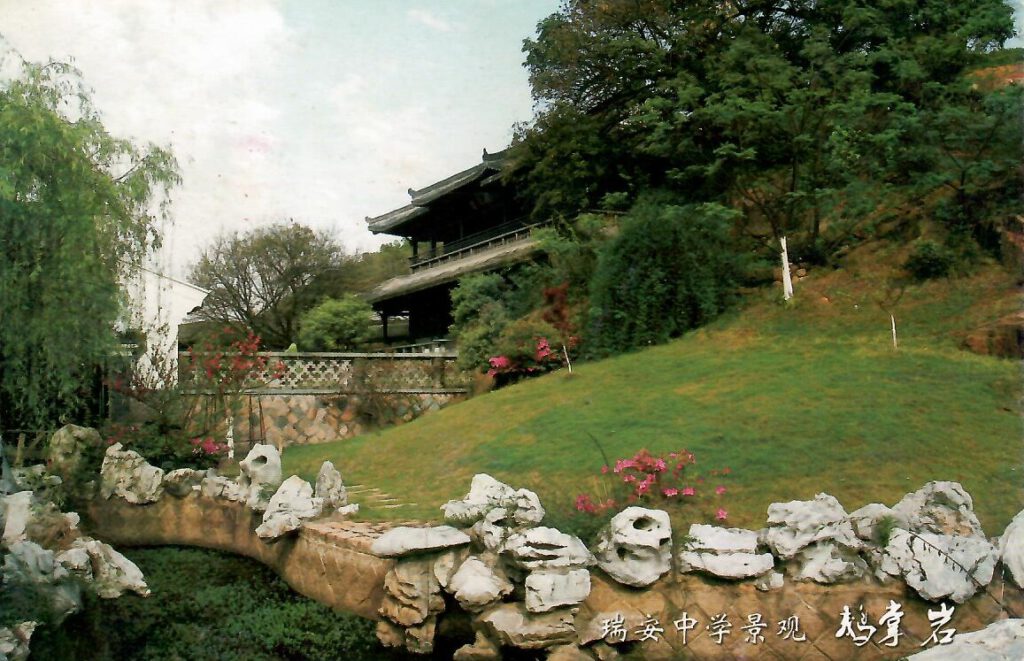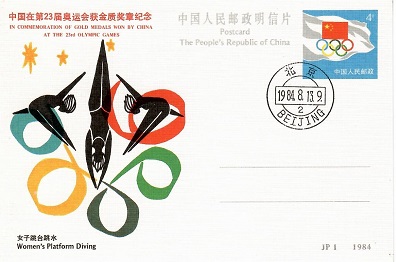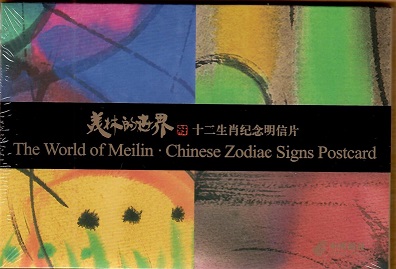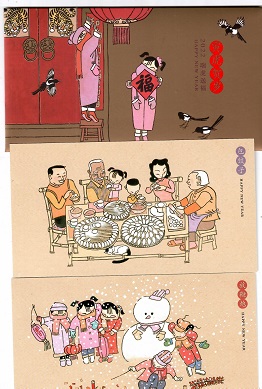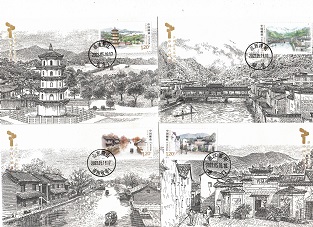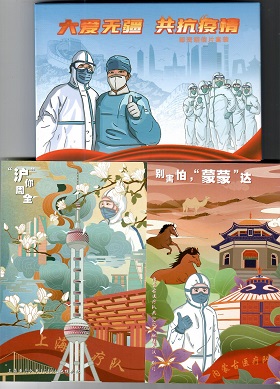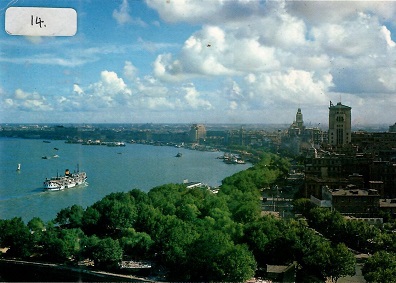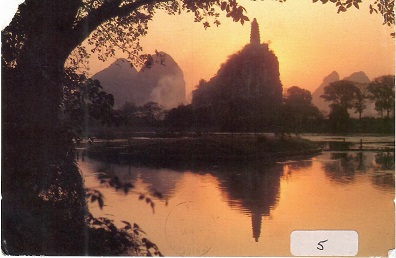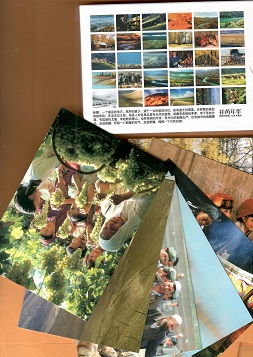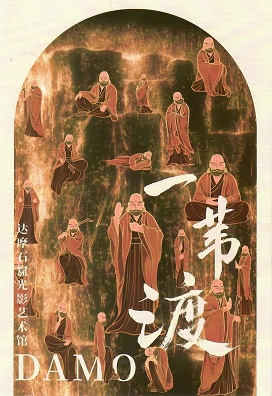-
Zhu Meng Zhong Guo
A hardcover book of 40 postcards in a cardboard cover measuring 1/2″x 8-3/4″ x 11-1/2″. Our scans A-C for this item show you, respectively, (A) the book as it slides into the cover; (B) sample of the fronts and reverse of the cards; and (C) a “Collection Certificate” inside the back cover. The cards all have pre-printed postage and are, of course, unused. Grade: 1
-
Zhu Meng Zhong Guo – sample cards
See description for 20307913A.
-
Zhu Meng Zhong Guo – certificate
See description for 20307913A.
-
1997 Handover of Hong Kong, depicting 29 June
Refer to a few recent entries (example: #20307911) and their descriptions. This was mailed from Shenzhen much later, with stamp and fully legible postmark. Grade: 1
-
1997 Handover of Hong Kong – parade
Refer to a few recent entries (example: #20307911) and their descriptions. This was mailed from Shenzhen much later, with stamp and fully legible postmark. Grade: 1
-
1997 Handover of Hong Kong – lanterns
Refer to a few recent entries (example: #20307911) and their descriptions. This was mailed from Shenzhen much later, with stamp and fully legible postmark. Grade: 1
-
Humen Feeling (set of 4)
Set of four art cards issued by China Post (pre-printed postage), captioned only in Chinese, noted as “Humen Feeling,” by the artist Tan Zhu Yao (we’ve transliterated the name) from an art academy in Dongguan, Guangdong Province. Our scan shows the fronts of three of the four cards; and the reverse of the fourth, which is the only card to have a “chop” from the Opium War Museum where they were bought. The little brown strip holds all four cards together. Grade: 1
-
Memory of Dongguan (set of 6)
A set of six cards, art from Leung Wing Ming (transliterated) with, presumably, sites in Dongguan, Guangdong Province. One of the six cards has a “chop” from the Opium War Museum where they were first bought; all six cards have an uncancelled stamp, so if you’re in China, they’re ready to mail. Grade: 1
-
Dongguan, Dream Postcard (set of 20)
Set of 20 unused cards, issued by China Post in 2010 with pre-printed postage. Our scan shows two of the cards — with scenes around Guangdong — and the cardboard cover holding them all together. Grade: 1
-
Dongguan, Opium Wars (set of 10)
The fronts of two cards and the back of another (the only one having this “chop” from the Opium War Museum in Dongguan), representing ten cards issued by China Post with pre-printed postage. We’re not certain how many opium postcards there are in the world — probably a few from Southeast Asia and the like — but here’s a start for you. The front of the set’s cardboard cover only is smudged with some ink transfer from those chops. It does not affect the postcards. Grade: 1
-
Dongguan, opium, four se-tenant panels
We think this item commemorates activities of Lin Zexu (Wikipedia: “Lin Zexu, courtesy name Yuanfu, was a Chinese scholar-official of the Qing dynasty best known for his role in the First Opium War of 1839–42. He was from Fuzhou, Fujian Province. Lin’s forceful opposition to the opium trade was a primary catalyst for the First Opium War.” Sorry that our scan doesn’t make any of this very clear. When fully extended, it is the size of four normal postcards. On one side, the first panel is Chinese-language text and the other three panels are one long artwork of actions during the Opium War that began in 1839. Now flip this over and the other side shows two panels (in the scan) and the reverses of two cards. So there are three actual postcards in those four panels, each with pre-printed postage because these come from China Post. One card (also in the scan) has the “chop” from the Opium War Museum in Dongguan. Grade: 1
-
Dongguan, Opium War Museum (set of 12)
This set of 12 unused cards from Dongguan’s Opium War Museum was, unusually, not issued by China Post. All information is in Chinese on the front of each card (we show four of the 12), and the reverse only says “Best wishes for your” in English. OK! One card has the large rubber “chop” from the Museum, which is an interesting and unusual way to spend a couple of hours if you happen to find yourself there. Grade: 1
-
1997 Handover of Hong Kong back to China – first-day covers
To make it completely clear right now: these are not actual first-day covers, but one postcard showing two of them from this 1997 event. The postcard itself was mailed from Shenzhen in 2019, with stamp and clear postmark. Grade: 1
-
1997 Handover of Hong Kong to PR China – mass event
From our short series of cards prepared in China for the 1997 Handover, then mailed from Shenzhen (in China) in 2019 with stamp and postmark. Grade: 1
-
1997 Handover of Hong Kong to PR China – schoolchildren
From our short series of cards prepared in China for the 1997 Handover, then mailed from Shenzhen (in China) in 2019 with stamp and postmark. Grade: 1
-
New Look of Guangzhou City
For almost too many reasons to mention, this is a wonderful unused postcard. We’ll try. Issued by the Chinese Government in 1990, it has pre-printed 15f coloured postage that matches the card’s main photo. The bilingual caption lets non-Chinese persons know what city this is. But most importantly, China is changing so fast that this would have become a historical record the day after it was issued. Trust us that the view is not “new” any more. Grade: 1
-
Ancient Towns of China III (set of 4) (Maximum Cards)
You may compare this set of four maximum cards with our entry 20307863, as it’s the next in the series. Our scan shows at least part of all four cards along with the cardboard cover holding them. Issued by China National Philatelic in 2019 with series reference MC(E)-20. Grade: 1
-
Paired sets (12)
There are 12 “First Day Covers” issued by China Post using postage meter imprint instead of stamps, and each with an actual postmark for the same day as the meter. But even though this is a sequence of 12 covers issued in 2018, the dates on each are different and run into 2019 also. On the back of each envelope, there’s Chinese text and a serial number. Those serial numbers are not the same for each envelope, and they’re not sequential either.
Now, imagine that each FDC has a corresponding postcard with the same meter and postmark date as its envelope. The serial number on the card does not match that on the FDC. The reverse of the postcard has a graphic the same as its FDC, and with more (Chinese) text.
So all in all there are 24 pieces: 12 FDCs and 12 postcards. In some ways they match, but in others they don’t. No, we don’t understand this either. Unused (of course) and Grades: 1
-
Trains (Maximum Cards, joint issue, set of two)
A joint issue between PR China and Spain, though China-based, with China National Philatelic set reference MC(E)-21. Issued in June 2019. QR codes on the backs of the cards. Grade: 1
-
Olympic Winter Games Beijing 2022 – Snow Sports (folio) – Cover
The whole thing comes in a cardboard cover measuring 8-1/2″ x 10″ (shown here). Inside, one piece that folds open to four panels. Do that, and on one side, each panel holds one postcard of a different sport (Cross Country Skiing, Alpine Skiing, Biathlon, and Freestyle Skiing. The cards of course are unused though each has an uncancelled stamp corresponding to the card’s particular sport. Now, flip this whole thing over and one of the panels has bilingual Chinese/English text, and one has a mint set of eight of those stamps. Another panel has details of issue from China National Philatelic, with QR code and holographic sticker guaranteeing authenticity. See our entry 20307930B for one panel. Grade: 1
-
Olympic Winter Games Beijing 2022 – Snow Sports (folio) – one panel
See description for 20307930A.
-
70th Anniversary of China-Slovakia Diplomatic Relations (maximum cards)(set of two)
One might think this was an odd topic for a set of maximum cards, but here it is nevertheless: a set of two cards jointly issued by PR China (set MC-123) and Slovakia in October 2019, with two different dates on the respective Chinese and Slovak stamps. Unused. Grade: 1
-
Ancient Thinkers (II) (maximum cards)(set of six)
Our scan shows the cardboard cover and two of the six (otherwise unused) cards in this set MC-124 from China National Philatelic. (The other four cards are in a similar style.) Cards are captioned in Chinese only, and have QR Codes for your further enlightenment. Grades: 1
-
140th Anniversary of Large Dragon Stamps (folio) – cover
Issued by China National Philatelic in 2018, this item measures 7″ x 10-1/4″ when folded. It opens to reveal four panels, so it is 28″ long when fully extended. This scan shows you the cover, with the orange sleeve off to the side. Remove the sleeve and open the folio. Each panel contains something different: three FDCs, and one postcard bearing a serial number (see our entry 20307933B). The back of the postcard is blank and the postage on the card is pre-printed. Grade: 1
-
140th Anniversary of Large Dragon Stamps (folio) – postcard
See our entry 20307933A for explanation.
-
7th CISM Military World Games, Wuhan 2019 (Maximum Cards) (set of 4)
These four (unused) cards, issued in October 2019, come in a cardboard cover with holographic sticker. We cannot help but observe that they must have breathed a sigh of relief (so to speak) that the Games ended when they did, despite Covid controversies. Two sets are available. Grade: 1
-
The View of God: China
Mailed in 2020 with four different stamps and clear postmark. Grade: 1
-
Speed of China! CRH
CRH in this case means China Railway High-speed, and this 4-1/8″ x 7-1/4″ card is one of theirs. It’s on thick paper stock, and with four different stamps and two clear and full Guangzhou postmarks, it would be an iconic addition to a collection of railroad postcards. Grade: 1
-
Nagqu (Tibet), A city of festive tents
Yes, that’s the English half of the bilingual caption on this 1992 unused card issued by the PRC with pre-printed postage matching the card’s main picture. Grade: 1
-
Wenzhou, school garden
This may be the largest number of different stamps (7) we’ve ever seen on a postcard, and the postmark over just one of them is a brilliant, clear red. You’ll need to know Chinese to make out the caption, but Wenzhou is one of those large Chinese cities you don’t know: a port and industrial city in Zhejiang Province, straddling the Oujiang River, on the East China Sea. Grade: 1
-
23rd Olympic Games, Women’s Platform Diving
Maybe lesser-known among Olympics postcards, but a simple example issued by the Chinese Government “In commemoration of gold medals won by China at the 23rd Olympic Games”. Postmarked August 1984, with pre-printed coloured postage. The reverse is blank. Grade: 1
-
The World of Meilin: Chinese Zodiac Signs (set of 12)
A famous and accomplished artist, though you may not know the name, Han Meilin ( 韩美林) has a resume far longer than our arms, and has added this unused set of 12 postcards, issued by China Post, to it. We do not know what the cards look like because they are still shrink-wrapped and in their original cardboard cover, which as you see does not give many clues. Grade: 1
-
Lunar Year of the Tiger 2022 (set of 6)
Issued by China Post, with pre-printed postage and remarkable lottery and QR code attachments … our scan shows the cover and two of the unused cards in this set of six. Hard to believe we’ve already cycled through the Chinese calendar, but so it is! Grade: 1
-
Ancient Towns (Maximum Cards) (set of 4)
Issued by China National Philatelic Co., Ltd., in 2022, this is unused set MC(E)-23. The artwork is remarkable, and it’s a desirable set of maximum cards. Grade: 1
-
Fight against the Epidemic (set of 32)
These are notable. Very much so. The unused set (with pre-printed postage) came from China Post in 2020, and we’re showing you two cards as well as the front cardboard cover as examples. All 32 cards in the set have the same serial number. This will be an historical reference, however oblique, to Covid for many years. Grade: 1
-
Shanghai, The Bund
Not postally used, but with message covering the reverse, and sticker/thumbtack hole, this card is only good as a space filler. It manages, however, to make The Bund look a lot less busy than it actually is. Grade: 5
-
Guilin, Pagoda Hill
Mailed several years ago with two different stamps and partial postmark, the sticker and abrasions make this card a space-filler only. Grade: 5
-
Back Lake in the Summer Palace
Mailed in 1981, with stamp and postmark and a prominent thumbtack hole. Grade: 4
-
Xinjiang (set of 30, and seven singles)
Sorry for the unruly scan but it was all we could manage. This entire lot includes one unopened, original wrapped set of what we believe to be 30 cards based on thumbnail shots on the back cover. As well, seven individual cards we believe came from a second, identical set. The only problem with these wonderful pictures is that the cards themselves have no captions in any language. The only identification is on the unopened set’s cardboard cover — in Chinese only. (Google Translate can handle that for you.) Grade for all eight items — the seven singles and one full set: 1.
-
Damo (A)
First, some Wikipedia information about the subject: “Bodhidharma was a semi-legendary Buddhist monk who lived during the 5th or 6th century CE. He is traditionally credited as the transmitter of Chan Buddhism to China, and is regarded as its first Chinese patriarch. According to a 17th-century apocryphal story found in a manual called Yijin Jing, he began the physical training of the monks of Shaolin Monastery that led to the creation of Shaolin kungfu. He is known as Dámó in China … Little contemporary biographical information on Bodhidharma is available, and subsequent accounts became layered with legend and unreliable details. According to principal Chinese sources, Bodhidharma came from the Western Regions, either Central Asia or the Indian subcontinent, and is described as either a ‘Persian Central Asian’ or a ‘South Indian […] the third son of a great Indian king.’ Throughout Buddhist art, Bodhidharma is depicted as an ill-tempered, large-nosed, profusely-bearded, wide-eyed non-Chinese person. He is referred to as ‘The Blue-Eyed Barbarian’ (碧眼胡).” We know that’s a lot to take in but this and the following card are also unusual, unused, and issued officially by China Post. The QR Code will likely tell you even more. Grade: 1

